AudioCulture
The noisy library of New Zealand music
Te pātaka korihi o ngā puoro o Aotearoa
Sneaky Feelings
Guitarist, singer and songwriter Matthew Bannister’s introspective memoir and history, Positively George Street: a personal history of Sneaky Feelings and the Dunedin Sound, frayed tempers and dented egos when it was published in 1999.
Bannister’s kitchen sink work challenged the hardened perspectives that had developed over two decades around the 1980s Dunedin independent music scene’s key musicians and their worth. It made contentious and contested environments that had increasingly been painted as cohesive and complementary.
As a key singer, guitarist and songwriter in Sneaky Feelings – the self-proclaimed outsiders of the Dunedin Double EP groups – Bannister was close enough to access revealing detail and removed enough to be honest about it.
Bannister’s narrative is consistent with what the group said in media interviews during their active years. The difference being, it was often drummer, singer and third songwriter Martin Durrant laying down the party line there. The group’s other main songwriter, guitarist and singer David Pine, is the one least heard.
In Bannister’s book, it is Pine who has the most to do with the broader indie community in Dunedin. When his voice is muted, those connections disappear or remain half seen and poorly examined. In ring-fencing his own group’s experience to the degree he has, Bannister may have drawn out his own group’s distinctiveness, but he also replicated the same defensive inward-looking perspective he accuses the wider indie scene of.
On top of that, Bannister has overlooked Sneaky Feelings’ wider influence in New Zealand. Their sound resonates in songs by Palmerston North groups The Remarkables and Three Leaning Men, and The Wild Poppies and Let’s Planet from Wellington, to name just a few.
Great Sounds: Dunedin Scene
It wasn’t always that way. The harder truth can often be found in more nuanced and balanced early accounts. David Taylor’s Great Sounds: Dunedin Scene from mid-June 1982 is one of the few detailed written sources from before the “Dunedin Sound” stereotype hardened.
Published as a one-off four-page scene run-down in Otago University student newspaper Critic, Taylor’s account has interviews with participants such as Hamish Kilgour, Robert Scott, Jeff Batts, Graeme Downes, Jane Dodd and Martin Phillipps, alongside sharp and critical editorial judgement.
In it, Taylor refers to the indie activity in Dunedin as the “Dunedin Scene”. The labelling is a kick on from the period description of Wellington’s post-punk expansion from 1979 to 1981, which had been called the Wellington scene or Terrace scene. Both city scenes had a distinctive feel and were represented as outbreaks of the wider post-punk influence in New Zealand. The idea of the Dunedin sound was still developing.
Sneaky Feelings debuted with The Chills, The Nerve, The Drones and Feedback on December 12, 1980 at the Deerstalkers Hall in Roslyn.
“Not that the new generation are without their faults. A tiresome lunatic fringe of musos and followers suffer chronic myopia. To them, music begins and ends in Dunedin. More generally a rigid set of values inhibits bands that don’t conform to the accepted norms,” Taylor writes. He goes on to identify Sneaky Feelings as a band apart even then, calling them “the only recorded band without links with the ’77 (punk) explosion.”
Talking to Bannister, Pine, Durrant and bass player Kathryn Tyrie in their Dunedin practice room, Taylor drew out the group’s beginnings in Pine and Bannister’s friendship at Otago Boys High and Durrant and Tyrie’s (and subsequently Pine’s) meeting at Otago University.
Amid what is mostly praise for the rising Dunedin scene, drummer Durrant then offers what would become a familiar refrain. “We were breaking into a cosy little scene. We got a big freeze-out,” he says.
With Max Satchell on second guitar and Pine singing, Sneaky Feelings debuted with The Chills, The Nerve, The Drones and Feedback on December 12, 1980 at the Deerstalkers Hall in Roslyn. The Chills were shut down after two songs. Their second show saw them sharing Dunedin Town Hall’s Concert Chamber stage with teen punks Bored Games and The Elevators on January 16, 1981.
Sneaky Feelings got some early television exposure after NZ music show Droppa Kulcha captured ‘You’re A Movie’ and ‘Bedroom’ on film at Dunedin’s 4ZB studios. The film is now thought lost.
1981 also found Sneaky Feelings onstage at Broom Valley Festival on February 1, followed by a University Hop a week later. They were one of a number of new indie groups onstage at the Shoreline Battle of The Bands in March before joining The Stones and The Verlaines, then The Clean and Feedback, at Otago University shows later that month.
An April performance at Queen’s Gardens and a Rock Against Racism appearance with The Chills at Otago University on May 1 showed a political concern not readily associated with Dunedin groups of the time. After a poorly received performance on the second night, Max Satchell left the group, eventually forming The Blue Meanies with Martin Kean and Andrew Brough.
When The Empire Tavern in Princes Street opened to the new bands in August 1981, Sneaky Feelings booked the venue’s second weekend with The Verlaines. They returned in September for two more weekends.
Label boss of the fledgling Flying Nun Records, Roger Shepherd, was in the audience for the first show.
Venturing north to Christchurch in November with The Verlaines after a mid-month weekend at The Empire, Sneaky Feelings played their first out of town shows at post-punk venue the DB Gladstone. As with all the new Dunedin groups, they’d find a keen audience in the Garden City. Record shop manager and label boss of the fledgling Flying Nun Records, Roger Shepherd, was in the audience for the first show. According to Bannister, he was the audience for the first show.
“(There was) one guy there on the first night, Roger Shepherd, who brought friends for the second night which spread for the third night…”
Beatles fan Bannister didn’t have far to look for a ready comparison.
“In a small way, the Gladstone was our Hamburg. In a strange place, we discovered how we could be ourselves. Away from the judgemental atmosphere of home, we started to develop.”
Back home in Dunedin, Sneaky Feelings were a popular support act going on before touring groups Blam Blam Blam, Hip Singles, The Mockers and Icehouse, in addition to monthly slots at the trusty Empire, often with The Verlaines.
There’s A Chance
For a group at some odds with their contemporaries, Sneaky Feelings sure played with them a lot.
After a December 11 show with The Nerve at Maori Hill’s Coronation Hall on December 11, they joined The Clean, The Stones, The Chills, and The Verlaines for a four day pre-Christmas run at the Captain Cook. A three-day weekend at The Empire in late January 1982 was followed up with Sneaky Feelings’ second crack at Christchurch as part of a four-band student orientation bill with The Clean, The Stones and The Chills at Canterbury University on February 26.
In the garden city again in mid-March for shows with The Verlaines, Sneaky Feelings recorded their contribution to the Dunedin Double EP. Three songs, ‘Backroom,’ Pity’s Sake’ and ‘There’s A Chance’ were recorded by Doug Hood and Chris Knox at a Barbadoes Street house.
Recounting the experience to Taylor in June 1982, the group were surprisingly positive, given their later doubts.
Matthew: “It’s important Sneaky Feelings have three songwriters. It gives us a diverse selection of songs.” Bannister, Pine and Durrant had each contributed a song to the recording session.
Taylor: “What about the EP, how did you find the experience?
Martin: “Hood and Knox tried to give the band what they wanted. They had passive roles. They recorded as opposed to produced the music.”
Kathryn: “They asked about doing certain sounds. They checked every detail with us.”
David: “They did a really, really good job. Much different to 4ZB coz you’re working with enthusiastic people. When we were recording for the Droppa Kulcha engineer at 4ZB I felt really embarrassed to play.”
The Dunedin Double EP appeared in June 1982, presenting four promising groups with songs to match, and quickly grabbed the imaginations of New Zealand indie fans. ‘Pity’s Sake’ was the pick of Sneaky Feelings’ three tracks, with David Pine’s downbeat vocal and lyric complementing a messy, but strangely apt musical mix.
Unfortunately, something was missing from one of the Sneaky Feelings songs – the bass line on ‘Backroom’. With money tight, only David Pine had been sent to Auckland to oversee the mix.
Still, it had got them all noticed on a national level. Rip It Up ran an omnibus piece on the new South Island groups, which cited Sneaky Feelings’ 1960s influences, especially Love, claiming the group had written 20 songs after hearing Forever Changes. They’d certainly heard and liked the Los Angeles band’s pinnacle album, but 20 songs?
Bannister: “It’s not true that we wrote 20 songs after hearing Forever Changes.”
Durrant: “It sounded like we wished to be in 1966 on Sunset Boulevard. I think it’s important that being in Dunedin, we get a longer perspective, so we’re looking at the last 25 years of rock and roll. You make a choice to suit yourself. In Auckland there’s pressure for the UK sound of 18 months earlier. We’re discovering a lot of music, especially US West Coast stuff. But we’re not trying to write songs in that idiom. We toss out songs written too much to a pattern.”
Be My Friend
Mid-July dates with rising Dunedin groups The Chant and The Rip and the Empire’s first anniversary show at month’s end (which Durrant sat out) preceded Sneaky Feelings’ first trip north to Auckland in mid-August. They were in the Queen city to record two more songs with Doug Hood at The Lab studio. Bannister’s plaintive ‘Be My Friend’ and Pine’s five-minute-plus ‘Amnesia’.
Auckland indie fans saw them for the first time at the Reverb Room and the Windsor Castle with tour mates The Verlaines.
Auckland indie fans saw them for the first time at the Reverb Room and the Windsor Castle with tour mates The Verlaines, and on an expanded bill at Mainstreet with Coloured Pencils and Nocturnal Projections. Late August dates at Cosgroves in Wellington and the DB Gladstone in Christchurch rounded out the trip.
Over the following months, Sneaky Feelings were mainly a live entity. After Dunedin shows with The Chant (at new venue Pitz) and Gamaunche (at The Empire), they saw the new year in at Christchurch’s Star and Garter with Mainly Spaniards. An Empire weekend with The Rip was followed by a Sweetwaters festival performance in New Zealand’s North Island in late January.
Orientation shows in Dunedin and Christchurch in February and March paired them with The Stones, The Verlaines and Mainly Spaniards before they bumped over the Southern Alps for a well received set at Punakaiki Festival near Greymouth in early April 1983.
Sporting a Ronnie Van Hout screen-printed cover of wildly varying colour quality, ‘Be My Friend’/ ‘Amnesia’ was released and slipped in the Top 40 for three weeks in June 1983. While the top side would fade quickly, ‘Amnesia’ proved a more enduring song, promising much for the next record.
Send You
Sneaky Feelings returned to Auckland in May 1983 to record and mix their first album Send You, over three days at Mascot Studios in Auckland with old hand Phil Yule producing. While they were there they stepped out live with Flak at the Rumba Bar, and reggae act Diatribe at The Esplanade on Auckland’s North Shore a week later.
Send You was an EP project that grew to an album. With Kat Tyrie playing her bass lines on organ to avoid further nerve damage to her fingers, the Dunedin quartet captured an album’s worth of superb Pine and Bannister tunes with Durrant contributing a singular strong song. The chemistry with Yule was sound and the now well-played songs all scrubbed up well in the studio.
With a strong album in the can, Sneaky Feelings gigged right up until Martin Durrant’s departure for Edinburgh. He’d be away six months before returning in February 1984.
The reunited Sneaky Feelings were headliners in their own right in Auckland in mid-April 1984 for concerts at the Windsor Castle.
The reunited Sneaky Feelings were headliners in their own right in Auckland in mid-April 1984 for concerts at the Windsor Castle. June dates with Able Tasmans and Vibraslaps at the Gluepot followed, as did a weekend at the Windsor Castle and a four-band showcase at the Gluepot with Children’s Hour on June 28.
Some of the June 1984, Windsor Castle show songs, including ‘Winston O’Boogie’, ‘I’ve Been Flushed From The Bathroom Of Your Heart’, ‘You Can’t Stand Alone’ and ‘Sense of Loss’, which weren’t available elsewhere, were released by Industrial Tapes later that year.
When it finally arrived in July 1984, Send You was greeted with delight. The album was so consistently good you could play it in its entirety and most did. There had only been one other Flying Nun Records LP of that quality up until then, The Builders’ Beatin Hearts.
Rip It Up’s George Kay nailed the debut LP’s strengths. “Send You was carried by Pine’s songs and Bannister’s guitar. ‘Throwing Stones’ remains a 6/8 masterstroke, manipulating classic Byrds and Dylan clichés. Durrant’s ‘Strangers Again’ was nicely clipped and understated, while Kat Tyrie’s keyboards added class to Pine’s breakneck ‘Won’t Change’, a compensation for the sluggishness of the previous ‘P.I.T Song’ and an ideal intro to the fine traditional echoes of ‘Everything I Want’.”
Throw in the downbeat ‘Not To Take Sides,’ the harmonious folk rock of ‘Someone Else’s Eyes’ and mid-tempo delight ‘Waiting For Touchdown’ and it’s easy to see why that proposed EP had became an album.
Speaking to Rip It Up for their July 1984 issue, Martin Durrant nails the group’s essential difference. “We sound American, basically. If you want to say what’s different about us from other Dunedin groups, it’s that. We like American rock n roll, that’s what we listen to most. But we listen to all kinds of music. I’m a fan of that point where country music meets soul, people like Percy Sledge. You’ll be hearing a country influence on the new album.”
Husband House
The Sneaky Feelings who recorded the ringing Celtic ballad ‘Husband House’ in Auckland in early 1985 was minus Kat Tyrie, who’d left the group after breaking up with boyfriend Bannister. Her replacement was John Kelcher, late of Christchurch’s The Wangs and a friend of The Blue Meanies’ Martin Kean.
The group were better organised in this period, having taken on the capable Jeremy Freeman as manager. They’d been regular visitors to Wellington (The Pulse), and Christchurch in the second half of 1984. 1985 was also busy, especially April, where they had six shows lined up at the DB Gladstone with The Chills, Look Blue Go Purple and Skeptics. A South Island tour with The Chills filled out the second half of the month with dates in Balclutha, Invercargill, Ashburton, Greymouth and Takaka. In amongst all that, Sneaky Feelings made time for a No Nukes benefit at Christchurch’s Gladstone. June brought more of the same with South Island town shows, while September had them back at Auckland’s Windsor Castle and the Gladstone.
When the majestic ‘Husband House’ finally arrived as a 12” single in October 1985, it climbed to No.16 in the pop charts.
When the majestic ‘Husband House’ finally arrived as a 12” single in October 1985, it climbed to No.16 in the pop charts during a seven week stay. Everything about the timeless song worked. It’s contemplative pace, the ascending sound, Kelcher echoing Bannister’s clipped picked intro with bass, the subtle string and horn arrangement, the backing harmonies and Bannister’s wistful frayed vocal. He’d spent some time arranging ‘Husband House’, which showed in the song’s strong emotional dynamic and sense of space.
The words were ostensibly about a Dunedin house where Christian girls sought future husbands, although that was never clear to the average listener. It sounds more like a yearning immigrant lament for distant shores, a theme echoed by the Steve Young video filled with Dunedin city scenes, surrounding countryside and beaches under a crisp clear winter morning sky.
If you missed ‘Husband House’ the first time, you could find it later that year on Take Sides, a cassette-only Flying Nun Records compendium of Sneaky Feelings recordings up to that point.
Better Than Before
Having made a brilliant album and followed it up with a popular and critical hit, Sneaky Feelings were well placed for their next move. A new album was what was really needed, Send You having created a welcome precedent. But what fans got was the muddled misstep of ‘Better Than Before’, a strong Bannister composition that was often praised in live reviews, but which failed to shine in the studio.
‘Better Than Before’ starts well with strummed guitar and neat observational lyrics before promptly tripping on its own shoelaces and never fully finding its feet again. There are plenty of good ideas there, but ultimately that wasn’t enough. The recording needed a beautifully balanced Bannister arrangement of the kind he achieved on ‘Husband House,’ but that was lacking this time.
David Pine’s ‘Wouldn’t Cry’ with its sunny Kinks/ Small Faces-ish vocal, featured Red McKelvie on steel guitar. It was a fine song, well-recorded, but was lodged on the flipside with John Kelcher’s Dunedin-recorded ‘Here’s To The Other Six’.
‘Better Than Before’ would nonetheless give Sneaky Feelings their third Top 40 single in May 1986.
Sneaky Feelings continued to be a strong live presence throughout the year. They were in Invercargill in mid-February before returning to Dunedin for shows at Oriental Tavern and Otago University. The quartet ended the month at Lincoln University near Christchurch with The Bats.
In early March 1986, they teamed up with Look Blue Go Purple for the well-received Strawberry Sounds (Dunedin music equipment hire firm and fledgling studio) tour of mostly university orientation shows. Both bands had made strong records and drew good-sized crowds.
Live film of Sneaky Feelings in 1986 exists from TV show True Colours, showcasing a more cohesive and flowing ‘Better Than Before’ with a better mix and balance. ‘Wouldn’t Cry’, again with Red McKelvie on steel guitar, was the other song captured.
The Dunedin group could be seen in late June on another teen show, Viewfinder, demonstrating how to write a song.
‘Take The Darkness’, an otherwise unrecorded folk rocker reminiscent of Send You’s upbeat moments, appeared in a live version on the Failsafe Records compilation tape Biding Our Time, along with the still unreleased ‘Broken Man’.
Sentimental Education
Sneaky Feelings’ vital second album was recorded at Mascot Studios in February and March 1986 with Victor Grbic, who had produced ‘Better Than Before’ and engineered their previous two records. Titled Sentimental Education, it is full of what Ian Henderson calls in issue six of Garage, “Matthew Bannister’s soft hearted sentimentalism and David Pine’s betrayed lover.”
The new album cost them $12,000 to record and featured the usual cello and French horn. Don McGlashan provided percussion, organ and tambourine on ‘Now’ and that’s Graeme Humphreys of Able Tasmans on piano and organ on ‘Trouble With Kay’ and ‘Backroom’. The Gotham City Horns (with Chris Nielson) did their thing on ‘A Letter To You’ and ‘Trouble With Kay’ while The Verlaines’ Graeme Downes arranged two songs and McGlashan one. Norma O’Malley provides backing vocals on ‘It’s So Easy.’
Rip It Up’s George Kay caught up with the group in late November 1986 for a two page December feature. He found all but Durrant (who was finishing his PhD thesis and was expected to join them later) soon to leave for Auckland after quiet farewell shows at the Oriental Tavern.
Speculating on Sentimental Education’s possible reception, Durrant ventured. “We’ll lose our hardcore garage fans, but they’ve never really taken us to their hearts. There’ll always be another group like The Clean, which they’ll like more. What we need is a wider audience. We’re in the ludicrous situation where having Flying Nun on our records means we won’t get played on the radio.”
In January 1987, lead single ‘Coming True’, an upbeat soul-pop Martin Durrant composition, announced the impending arrival of Sentimental Education. It was a brave move that would have worked a lot better if Durrant had the voice to fully carry it off.
When the new album arrived in March 1987 after a national university orientation tour with The Verlaines, it met with lukewarm response. Bannister believes a let up in Pine’s songwriting meant they had fewer songs to choose from. Pine said too much time was spent on arrangements and not enough on vocals.
It didn’t help that they buried the best recordings on side two. At the time, revisits of ‘Backroom’ and ‘Amnesia’ seemed unnecessary, although The Verlaines carried it off with ‘CD, Jimmy Jazz and Me’ on their second album, Bird Dog. Of the other songs presented, ‘Trouble With Kay,’ and ‘It’s So Easy’ are the strongest and they were released as two sides of the album’s second single. You do the maths.
Sentimental Education didn’t chart in New Zealand. As with ‘Better Than Before’, it “fell into the gap between the commercial stations and the student stations.”
Waiting For Touchdown
After partnering with The Verlaines at Auckland’s Galaxy Ballroom in February and a farewell weekend with Aardvark at Dunedin’s Oriental in April 1987, Sneaky Feelings headed for London and Europe. A compilation, Waiting For Touchdown, which had gathered up the best tracks up to and including ‘Better Than Before’ and its flip sides was already out in Europe, Australia and the UK, where David Swift reviewed it positively in NME. Sentimental Education was to follow during the tour.
Kicking off at Bristol’s Tropica Club with The Chills, Sneaky Feelings headed down to London and Dingwalls then on to Europe.
Kicking off at Bristol’s Tropica Club with The Chills, Sneaky Feelings headed down to London and Dingwalls then on to Europe. They had Ivan Purvis as soundman, originally from Wellsford, north of Auckland, he was resident in Dunedin in the early 1980s. Dates in Hoogstraten in Belgium with The Chills and at Hamburg’s Mitternacht Club on the infamous Reeperbahn followed. Then it was Koln, Gammelsdorf, Enger, East Berlin and Frankfurt before jumping the border to Holland and back to England for shows at Bristol, Sheffield and Hull, and finally home.
When Sentimental Education was released in the UK and Europe the notices were strong. Everett True in NME (as The Legend) found the album full of “the kind of tunes (David) Westlake and The Weather Prophets would kill for. The sort, which gently creep up on you when you’re not listening and hang around for days and weeks after.” He praised ‘Amnesia’ and ‘Trouble With Kay’ although he wrote “the album’s real centrepiece is the McCartneyish ‘Its So Easy’, the fabbest B-side ever to have winged its way over here from Australasia.” Better still was the CD version of Sentimental Education, released post-tour in Europe, that added ‘Husband House’, ‘Better Than Before’ and a remixed ‘Broken Man’.
Hard Luck Stories
Back in New Zealand, Sneaky Feelings went their separate ways. David Pine went to university in Dunedin, Bannister and Kelcher to Auckland and Martin Durrant to Wellington. There were shows in July in Napier, Palmerston North, Wellington and Auckland, and intermittent appearances over the following months in Christchurch and Auckland.
Sneaky Feelings played 50 European dates in an ever expanding tour.
Meanwhile a second European tour was slated in August 1988. With Martin Durrant unavailable, Ross Burge occupied the drum seat. Sneaky Feelings played 50 European dates in an ever-expanding tour. There were no bad performances, but progress was minimal and they were still playing the same size venues as the previous tour.
Their third album, the Pine-dubbed Hard Love Stories, was typically not available, the artwork having been delayed in New Zealand. Recorded on their return from Europe the first time around, it is another disappointing work. Despite some good ideas, including Bannister putting a Philip Larkin poem to music, the songs just aren’t there. It didn’t help that Flying Nun Records left off a key track, a cover of ‘Long Time Gone’, which was included with all copies of Hard Love Stories as a one-sided 45 instead.
Sneaky Feelings finally made the cover of Rip It Up in February 1989. Interviewer Chad Taylor asked Bannister about influences. “We’ve been compared to Postcard bands in the past – we get that a lot in Europe where people are always pulling out Orange Juice and Aztec Camera. That’s obviously what we remind them of but since I’m Scottish myself I’ve got slightly mixed feelings about it. I liked the acoustic sound and quite sophisticated song structures of the Postcard bands when they first came out, but I didn’t follow them much – they were too contemporary for me,” he laughed.
Talk then turned to the unfolding musical times and the rise of Sonic Youth, Stooges influenced bands and the revival of rock. Inevitably as all their interviews would do, the talk turned to Sneaky Feelings’ place in the contemporary music environment, ever conscious to the very end.
There was a final New Zealand tour in March 1989, following February shows with The Go-Betweens, a group whose music echoed in some Sneaky Feelings compositions. Sneaky Feelings bowed out for the first (but not last) time at Dunedin’s faithful Oriental Tavern, which reopened to bands for the occasion. They also appeared in a guest spot on The South Tonight, a lower South Island magazine news show.
Maybe You Need To Come Back
Flying Nun Records’ 1992 reissue of Send You brought Sneaky Feelings to New Zealand stages in July that year. With Bannister’s new group Dribbling Darts of Love in support, the Dunedin quartet visited The Gluepot on July 22 and Dunedin’s Crown on July 28 and 29, before heading north to Christchurch and Warners on the 30th. The following month, they were at Ali Babas in Wellington for two dates.
With the old crew back together and still getting on, they couldn’t resist putting some new songs down. Included as four bonus tracks on the reissue, two of them are particularly strong. The spare ‘Maybe You Need To Come Back’ and Pine’s alt-country anticipating ‘Cry You Out Of My Eyes’.
To coincide with the publication of Bannister’s book, Positively George Street, another collection was gathered by Flying Nun Records in 1999, revealing for the first time the full spread of Sneaky Feelings’ music.
Nearly 20 years later, in 2017, Sneaky Feelings announced that they were releasing a new album, Progress Junction, on Flying Nun, and reuniting to perform at the Others Way festival on Auckland's Karangahape Road on 1 September.
The new material was not too far removed from their earlier work, Matthew Bannister told the Sunday Star-Times’ Grant Smithies: “It's still guitar pop-rock. Martin still writes soul-based pop songs, David’s still good at writing atmospheric lyrics and telling stories, and John’s songwriting has developed a lot, which gives a strong new voice to the group. And my songs are vaguely contemporary, I guess. I talk about living in New Zealand in these times we’re in, and, you know… retirement homes.”
Retirement homes? Smithies responded: did Sneaky Feelings consider themselves the geriatrics of the local indie pop scene?
“Well, yes, I guess, you could say that, but we aren’t the only ones. There’s a lot of us around. There’s clearly a big market out there for geriatric rock.”
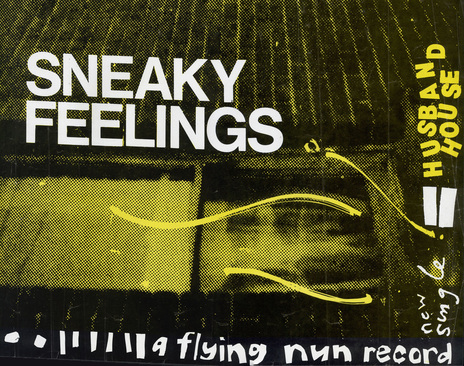
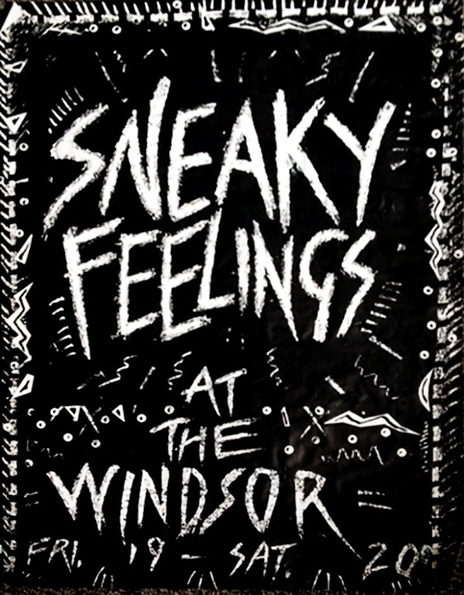
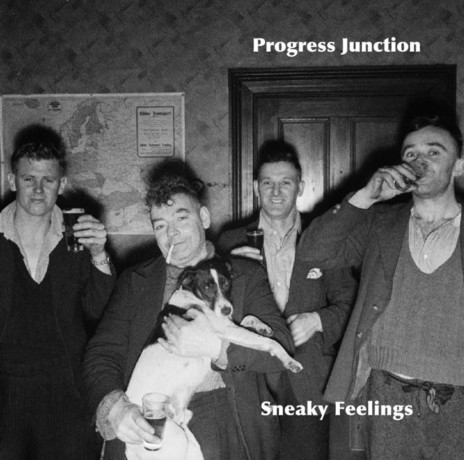
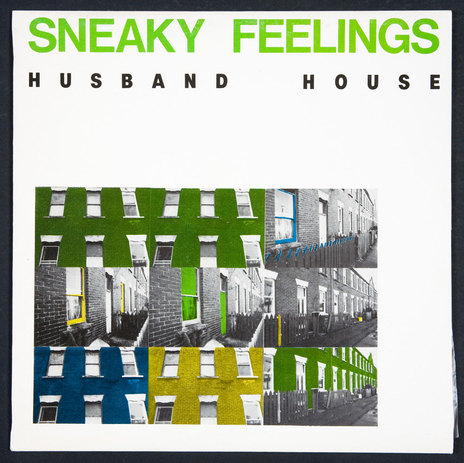
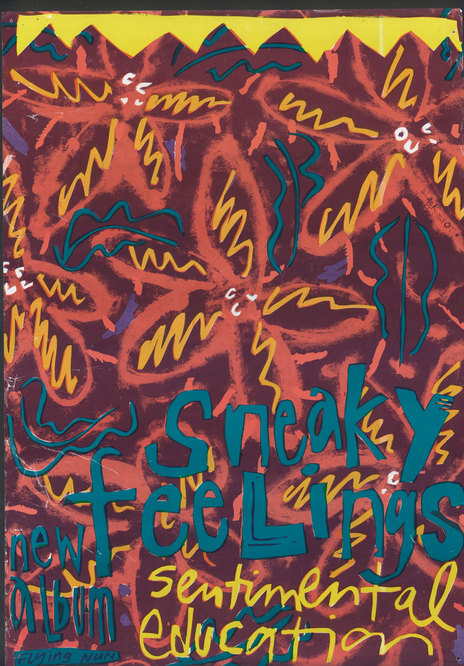
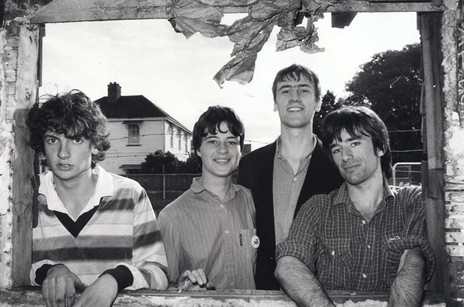
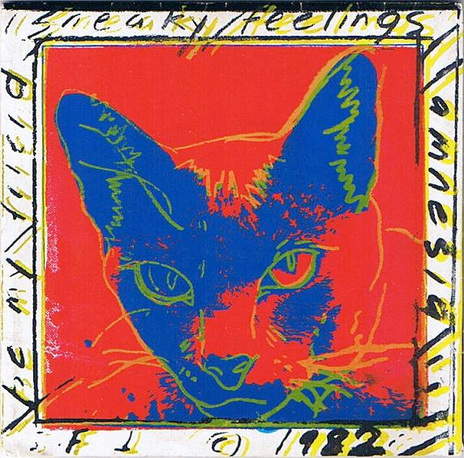
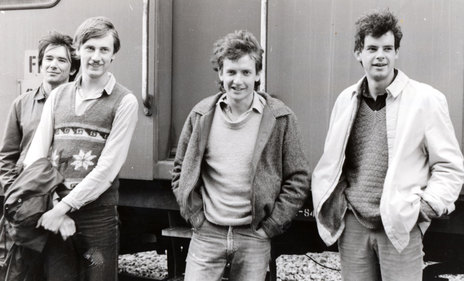
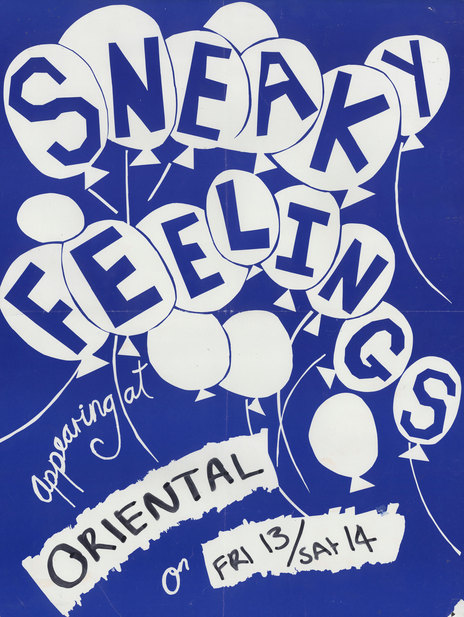
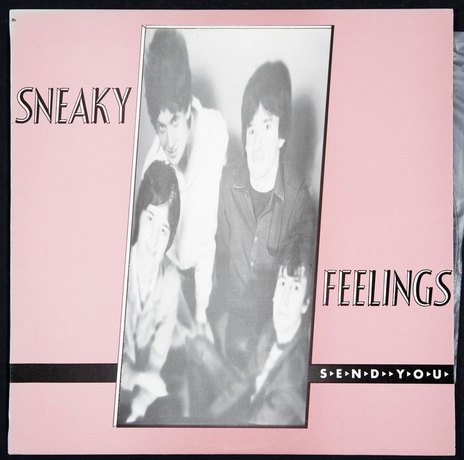
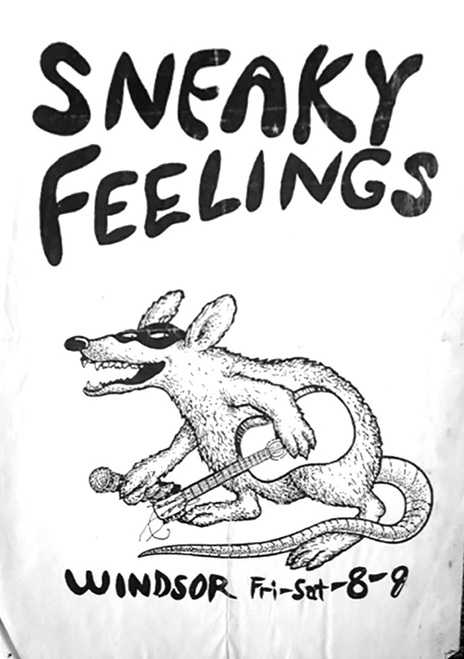
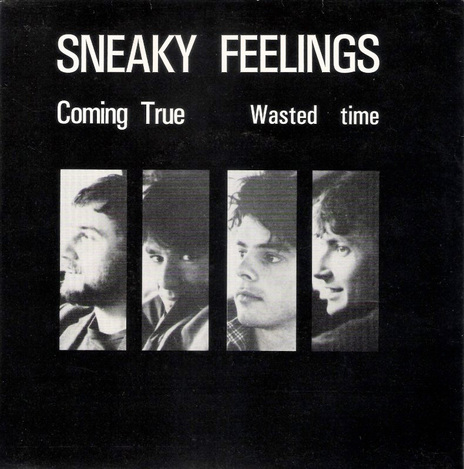
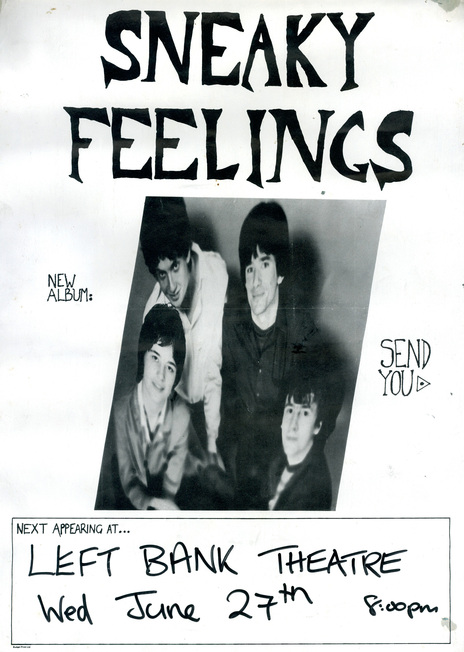
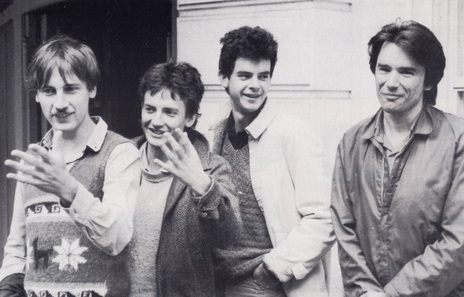
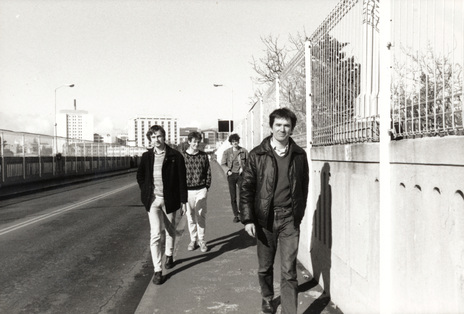
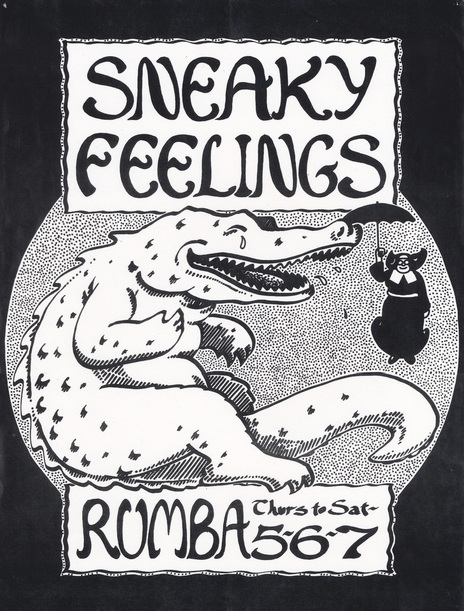
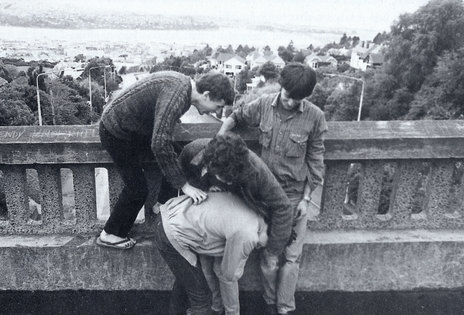
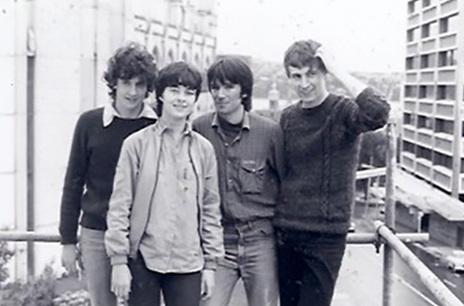
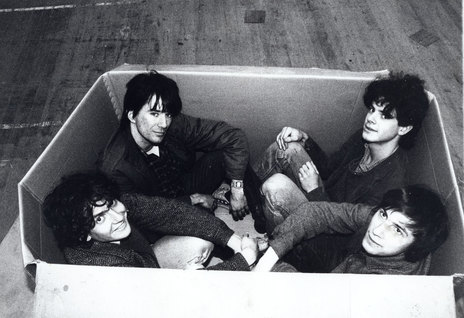
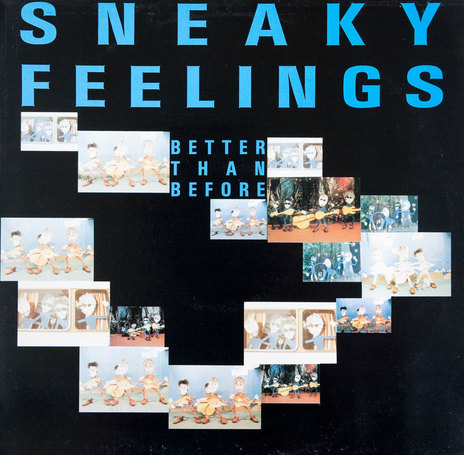
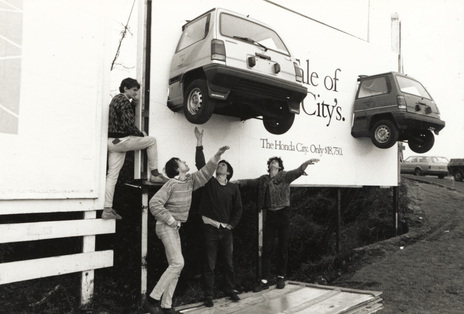
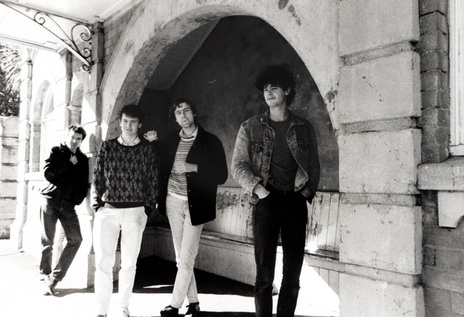
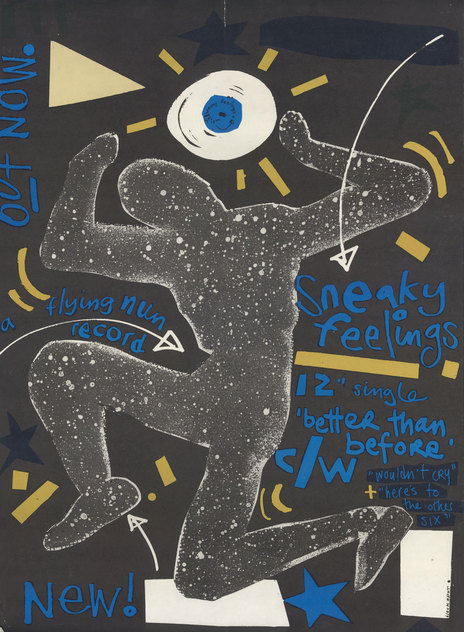
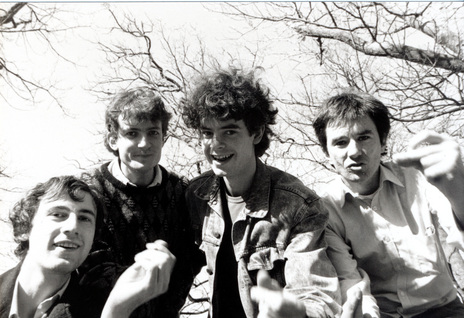
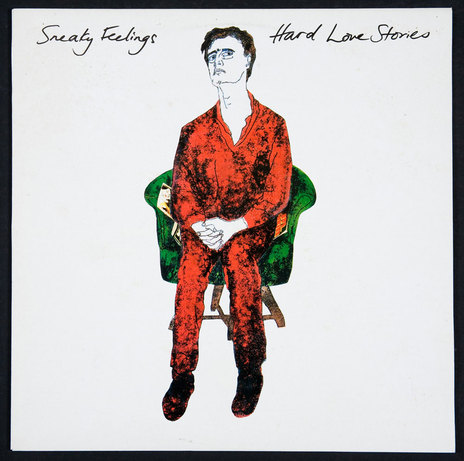
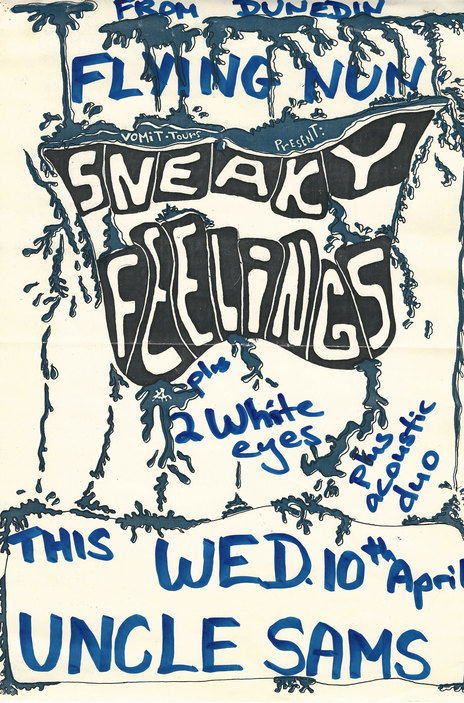
The name Sneaky Feelings was taken from an Elvis Costello song title.
Future Matthew Bannister groups included Dribbling Darts of Love and The Weather. He has recently released his take on The Beatles’ Revolver as Evolver.
Matthew Bannister was co-opted as guitarist for The Mutton Birds, who performed a version of his ‘Not To Take Sides’ live.
David Pine wrote ‘I Love The News’ for Death Ray Café. Pine was also bass player in Dunedin’s The Moas, who released an EP called Spaz Out! With The Moas on Flying Nun Records in 1987.
David Pine is New Zealand’s High Commissioner to Malaysia.
Bic Runga covered Martin Durrant’s ‘Stranger’s Again’ on her Try To Remember Everything compilation in 2008. The song was originally recorded for a Radio New Zealand session.
David Pine and Martin Durrant of Sneaky Feelings were two thirds of The Bleeding Allstars, who contributed a version of Toy Love’s ‘Ain’t It Nice’ to the Chris Knox benefit album Stroke in 2009.
Matthew Bannister - guitar, vocals, keyboards
David Pine - guitar, vocals
Martin Durrant - drums, vocals, keyboards
John Kelcher - bass, vocals, keyboards
Kathryn Tyrie - bass, keyboards
Ross Burge - drums
Visit our sister site
NZ On ScreenMade with funding from
NZ On Air



